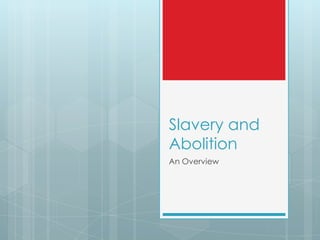
Slavery and abolition
- 2. Origins Slavery was not an institution created in the United States, It’s roots go back more than 2 millennium. It has footprints in most Ancient civilizations. Egypt Greece The Roman Empire China Pre-Columbian Societies in the Americas
- 3. The Colonies The earliest slaves were White indentured servants from England As the Colonies grew and agricultural production increased indentured servants were not enough and the African slave trade took hold Slavery was legal in all the Colonies except Georgia until 1751 when it was the last to legalize the practice The Plantation System developing in the South was a major force behind the booming slave trade.
- 4. Slaves Slavery as an institution crossed races, gender, and ages with children and the elderly used as slaves Slavery is mainly associated with the African captives brought to the U.S. and constitutes the vast majority of slaves. White people were also slaves, though the term used for most of these was indentured servants During the Western gold rush Asians were slaves used mainly for prostitution and dangerous labor
- 5. Abolitionists Frederick Douglass Abolitionistswere those people, both black and white, man and woman, and Northerner or Southerner who believed that Slavery should be ended and worked to do so Radical Abolitionists felt the same way but used extreme measures in their fight to free the slaves.
- 6. Men William Lloyd Garrison William Lloyd Garrison Creator of the American Anti-Slavery Society and Publisher of the Liberator. Had a $5000 bounty placed on his head by Georgia Legislature William Still Known as the father of the Underground Railroad he helped scores of slaves to freedom and kept records on all those he helped John Brown Radical Abolitionist famous for his raid on Harpers Ferry West Virginia. Was sentenced to death Frederick Douglass Noted orator and escaped slave, he was an avid believer in equality for all people: black, White, Native American, Asian, new immigrants, and women. He is among the most famous abolitionists
- 7. Women Women Abolitionists had a large part in fighting for the end to slavery Harriet Tubman
- 8. Notable Names Susan B. Anthony Sojourner Truth An escaped slave herself she helped recruit black soldiers for the Union Army Lucretia Mott A Quaker minister who made her home a stop on the Underground Railroad Susan B. Anthony Better known for her connections to women's suffrage, she was also a staunch advocate of Abolition Lucy Stone Organizer of the American Anti-Slavery Society in Boston who taught escaped slave to read and write. Harriet Tubman An escaped slave, known as Moses for her visions from God, she made multiple trips to the South to help escaping slaves
- 9. Documents The Fugitive Slave Act of 1850 Was part of a compromise between Southern Slave Owners and Northern Free- Soilers requiring escaped slaves to be returned to their owners. The Emancipation Proclamation An Executive Order issued by Abraham Lincoln on January 1st, 1863 proclaiming all slaves in Confederate territory free The 13th Amendment Passed on April 8th, 1864 this Amendment to the Constitution officially outlawed slavery in the United States
- 10. Civil War
- 11. California Connecticut Illinois Indiana Iowa Kansas Union Maine Massachusetts Michigan Minnesota These States New Hampshire remained loyal to New Jersey New York President Ohio Oregon Abraham Lincoln. Pennsylvania Rhode Island Vermont Wisconsin
- 12. Border States BorderStates were those who had slaves but remained loyal to the Union. Maryland Delaware Kentucky Missouri
- 13. Alabama Georgia Louisiana Confederacy Mississippi South Carolina Tennessee These states Texas seceded from the Virginia Union electing Florida Jefferson Davis as North Carolina President. Arkansas
- 14. International Many people of different ethnicities and cultural backgrounds participated in the American Civil War.
- 15. Hispanic Heritage David Farragut Many Hispanic people played roles in the Civil War for both the Union and Confederacy Admiral David Farragut fought in the Union Navy and stated the famous line, “Damn the torpedoes, full speed ahead” The Garibaldi Guard bough in the Union Army and had members from many European Countries including Spain and Portugal Corporal Joseph DeCastro was the first ever Hispanic to win the Medal of Honor for Valor at the Battle of Gettysburg Loreta Janeta Velazquez was a 19-year old Cuban woman who fought for the Confederacy at Bull Run and Shiloh disguised as a man.
- 16. Asians Joseph Pierce Though most Asians in the U.S. were found in the Western part of the country there were a handful who fought in the Civil War on both sides. Joseph Pierce was brought to the U.S. from China by his adopted father and was a veteran of Gettysburg and Antietam Stephen and Christopher Bunker were children of Siamese descent who fought for the Confederacy
